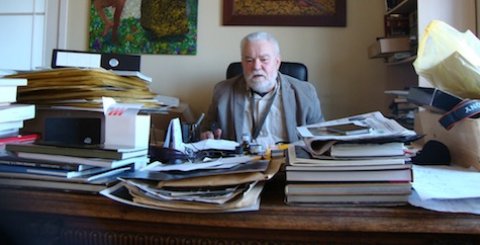
Antanas Sutkus: Brazil opened my eyes
Juste Kostikovaite
17/05/2012
“Antanas Sutkus (1939) is justly called the Homer of Lithuanian photography – the continuous oeuvre of his whole life is an epic, assembled from fragments of everyday life.
His distinctive works convey an archetypal attitude that has deep-seated relations with his community; however, the power of his artistic language and the scope of his oeuvre put the name of the photographer into the ranks of the creators of the world's culture. The phenomenon of the artist's oeuvre could be defined by the individuality of his artistic expression, a steady program of his ethical ideas and his existential aesthetics. The aim of this book is to present his creative evolution as clearly and thoroughly as possible, to reconsider earlier interpretations and to get to know the author anew. Having entered the 21st century, Sutkus has not changed his opinion; on the contrary – the exposure of his archives only reaffirmed his unusual artistic sensitivity. The photographer does not drown in the overall havoc raised by the dehumanization of society; he does not betray his hero, that nameless man, that gray mass in particular, that fills up our real life and his photographic reality as well.”
The above is an excerpt from the book “Antanas Sutkus. Retrospective”, written by the curator, critic and art historian Margarita Matulytė.
For this interview, Antanas invited me to his house in a district in Vilnius called Naujininkai, which is located near the train station. We are sitting in the studio with Antanas, where all his books and photographs are scattered and piled up one on top of the other – spread on the floor, chairs, table and shelves. The messy clutter, the curious dog, and a smiling Antanas – the atmosphere is not restrained at all; on the contrary, it's very relaxed and inviting. But at the same time – quite serious. He starts with questioning me.


A.S. So, what did you say you are studying?
J.K. Curating contemporary art.
But what do you mean by contemporary art?
There are different ways of trying to define what is contemporary art. I prefer to answer to this question with the formulation by the curator and critic Dieter Roelstraete: “What is NOT contemporary art?” In his essay, he speaks about several main features of contemporary art, one of them being time, while the others are how precisely art inserts itself into contemporary times, but at the same time, avoids the tropes or practices of being called art.
I can see now that there are a lot of art historians, but curiously, art survives time without asking those who were writing the art history. I noticed that in Lithuania now, several art historians are actively doing research. They chose their phD theme, selected artists, and later, all their life, just modified their theme. I think this way of working – with just one theme your whole life – is completely boring. If I had just one idea and then tried to adapt my whole life to it, I simply could not do it. Someone has to analyze and criticize the process, the change. The creative process, not the result, has to be explored, but without trying to produce some sort of academic illustration of their own thesis. The exception would be the photography historian Margarita Matulytė.
She is an author of the recently published monography “Nihil obstat. Lietuvos fotografija sovietmečiu”.
Can you tell me more about your success with the exhibition in the Oscar Niemeyer Museum in Kuritiba (Brazil), where it was on display at the same time as Francisco Goya’s etchings?
My exhibition in the Oscar Niemeyer Museum lasted for four and a half months. They even asked me to prolong my exhibition for two more weeks – because in just the first two weeks, the usual monthly amount of visitors had come in to see the show.
You will also have an exhibition in Ecuador, then the photography biennial in Brazil, and then the show will be presented in Salvador, Sao Paulo and Belo Horizonte, in Brazil.
Yes, it seems that I need to visit Brazil one more time. At the moment, the RTR Gallery in Paris, in collaboration with the Agathe Gaillard Gallery, is presenting “Free Love”, an exhibition featuring 45 (mainly vintage) prints by Jean-Philippe Charbonnier and myself. But I am not going to Paris, but rather to Kiev, where I will have an exhibition featuring 120 of my works. As for Brazil, at the moment it is really problematic because I have health problems and actually, my doctors do not recommend flying or extensive traveling. Despite that, the trip to Brazil literally opened my eyes. When I lived there, people were extremely friendly to me. In two days, all of my neighbors, and even the policeman, already knew me and was saying hello to me. I would often visit this cafe near my house; after a couple of days, even passersby were nodding to me. And this cult of children!
At the same time, they have extreme inequalities in Brazil, which form great social fragmentation. For example, extreme wealth, which you have probably seen, and then, not too far away, huge favelas. The favelas formed when the large farmers became rich land-owners, and the country started undergoing a massive industrialization; people from the countryside flooded the cities, where they found themselves living on the fringes of the city and society.
Yes, but I am trying to compare the situation of today's Brazil with our situation in Lithuania. It was not during the last century when the rich and poor classes formed in our country. What is the meaning of such processes when in one year, 14 millionaires appear in our Parliament? And when in the villages – big, private land properties are forming? And, do you think it is morally ethical when in Lithuania a whole 5th of the population receives support from the “Food Bank” (a charity project which gives people the opportunity to donate food to those in need)? Going back to the comparison with favelas: here in Lithuania, we have to be prepared for harsh winters. Favela people do not need heating, they don't eat meat often, they do not need warm clothes. I must admit that I, personally, was not taken on a tour through the favelas, although I did meet one person who promised to take me there. Unfortunately, that day the police went on strike, and nobody wanted a foreigner to die there during drug fights or something like that.
Maybe this situation in Lithuania is also one of the reasons why collecting art is seen as an unnecessary activity at the current moment?
All I can say is that our country is taking the wrong direction with collecting. I was managing the Photography Art Association – the only such organization of its kind in all of the Soviet Union during its last 20 years – and later on, throughout independence, for an additional 13 years. I think that at that time, my sacrifice of my personal life and time was meaningful for this activity of managing such an organization. I really feel this way when I look back on what we have achieved by our enthusiasm. For example, in the Château d'Eau, Toulouse, where I had an exhibition in 2011, they showed us their archives, in which they had old posters of my and Aleksandras Macijauskas's exhibitions which were shown there 25 years ago. All of those exhibitions were produced by us at a time when exhibitions like that were almost impossible to even conceive of. Nowadays, photographers in Paris wait for two years to get into the Château d'Eau in Toulouse, which was founded in 1974 by Jean Dieuzaide, and was the first gallery in France to be devoted solely to photography. I realized now, that in soviet times, the fact that we were able to have these exhibitions can be explained only by the wish of the soviet system at the time to use us as a means to demonstrate that soviet artists also are, or can be, modern. They wanted to show that soviet art can be multifaceted and Western, in a way; that there are artists who are critiquing the social-realism style. But at that time, 30 years ago, in order to be able to have these exhibitions, I was involved in a lot of networking – I was spending a lot of time with heads of government, speaking, and having some drinks with them. At that time, curators from Western Europe were much more favorable. I cannot say the same thing about the current times. Only those artists who have left the post-soviet arena are valued. It is hard to understand for me why Western art discourse is not interested in what was done in Eastern and Central Europe during the soviet times. I, myself, feel this reluctant attitude in my colleagues from Western Europe.
Going back to thoughts about the system, and of art being one of the tools it used to present itself during the Cold War. Now, if you compare societies, the society of communism collapsed by itself; although, of course, it would not have been possible without the help of Gorbachev. In my opinion, our independence movement – “Sąjūdis” – would not have existed if Gorbachev had not allowed us the freedom of speech.
My mother says the same.
Yes, so one needs to listen more closely to what philosopher Arvydas Juozaitis has said. Before, you would sit in jail just for exercising free speech. When I was a member of the party (against my own will), at the same time, my soul friend of today, the priest and monk Julius Sasnauskas, was imprisoned for his political activities. I did not know him at that time. It was horrible, when I think back, because now I feel like a fascist who says that he did not know that people in the concentration camps were dying.
Let's go back to the collectors. It seems that in the last decade, you have been enjoying great interest from them, especially the international ones. Do you ever meet with them personally?
The problem is that curators usually know the collectors, and protect them from having direct contact with the artist. Sometimes, they do not even disclose their contact information.
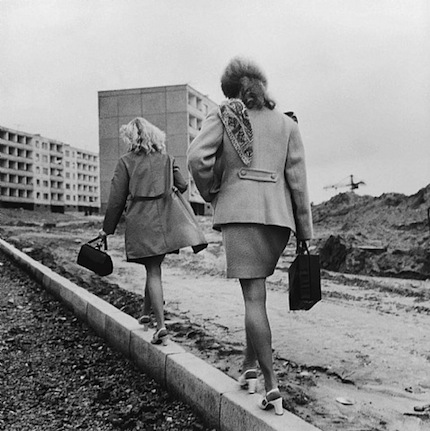
Lazdynu pradzia, Saligatvis, Vilnius. 1976
But institutional curators do not sell works, for instance, curators of museums such as Oscar Niemeyer, or the Toulouse Museum.
Yes, but then they secure the author fee and spread the word about art photography around the world.
In Lithuania, I have a feeling that announcements about your exhibitions and your works generate articles and news, but they do not generate further discussion.
I felt this especially in Toulouse. When I had an opening there, Le Figaro, Le Monde and other media came to cover the event. No one from the Lithuanian embassy came, even the Cultural Attache did not come. I came back to Lithuania – and again – no reaction, no information. And the same scenario, more or less, repeats itself again and again.
Why do you think that is so?
I do not know what, exactly, is the problem here. Maybe the Lithuanian people are jealous? I am not sure. Just recently, I had a exhibition in Paris in which a group of very diverse artists were participating: Stanikai, Pigagaitė and Liškevičius were featured. We were so happy with our success there, and with each other, and about the Cultural Ministry holding a talk during the opening. Now, imagine someone saying the same thing, or something similar happening, in Lithuania. Hard to imagine, isn't it? Maybe we do not have an intellectual critical mass that could meet and talk about themes which are neither profitable nor networking-based; an intellectual critical mass that would drink tea and whiskey not only with those people who might be useful to them in the future, but rather with people with whom it is simply interesting to exchange opinions with.
And how about Viktoras Butkus, the entrepreneur who bought so many artworks and now plans to invest millions of litas in the building of the new museum?
I think Viktoras Butkus and Arūnas Gelūnas are the two exceptional people at this difficult moment. I would say that Butkus is like Guggenheim and Soros together. But you can imagine that his path is not so easy. The Lithuanian government understands that Butkus is going to give a gift, but then Lithuania will be obliged to support the maintenance of the building and to take proper care of the collection.
Maybe the same situation is going on now with the National Gallery of Art, namely, the building has been beautifully reconstructed, but there is not enough money for collecting and programs.
If we are going to continue the same line of thought with our cultural heritage, it will simply vanish. I would say everything depends not only on the directors of museums, but also on the political will and a broader understanding of what cultural heritage is. It depends on what the museums are investing in: are they investing in the furniture, or in the artists, who are disappearing together with their artworks? Artists are dying. I also have examples – my very good friend, a photographer, is struggling with staying alive. A curator was visiting me and I told my friend to bring all of his photographs, which he then did. The photos were sold for a very low price, and my friend agreed to it. What can this person do? How can this photographer think about Lithuanian cultural heritage policy when he does not have the money to buy his blood pressure medicine?
I once had an argument with Algirdas Brazauskas, the prime minister at that time, and proposed that the government should buy the photographs taken by our great, classic masters of photography. The prime minister answered that the collection has to be first presented to the state. No businessman has ever had to present some buildings or houses which they have built. I said, why do the children of these classic artist have to be poor? If I had the money, I would buy all of the Lithuanian classic photographs.

Vilnius. 1963
What do you think of the decision of Vilnius Municipality to buy Fluxus collection?
If this offer had come from some other country, let's say from Chukotka, then we would expect that they do not understand art and that it is highly possible that the collection will just disappear into the trash. But at this moment, American museums and collectors know everything, and if they passed on the opportunity to buy the collection that Lithuania ended up buying, it means that the collection is worth nothing. More importantly, it is not the mayor of Vilnius, Artūras Zuokas, who should make these kinds of decisions. If he wants to, he can buy it with his own money.
But we could establish a Jonas Mekas museum, we could establish an Antanas Sutkus museum.
It would be worthwhile to establish a museum devoted to the generation of Lithuanian photographers who created what is known as “the Lithuanian School of Photography”.
+++pagesplit+++
But Lithuania is already the main protagonist, the landscape, the very fabric of your photos; it does not need “to come”, to appear, or to confirm itself, as it already is in the content of the works.
Yes, but when talking about image-making, this is the best form of image-making, but nobody is using it. I remember president Vladas Adamkus. I really respected his practice of usually taking artists and exhibitions along with him when he was visiting foreign countries. I was with him in Czechoslovakia and in Dublin, Ireland. I think he took along other artists as well. I think that photography is a very suitable art form with which to represent a country. A lot of people do not know anything about us. A lot of people say that we need to become more “European”. In answer, I would say that we have been, and we still are, in Europe. During the occupation, morals and ethics were suppressed, but at the same time, we had an opportunity to cherish them, to save them, to survive through them.
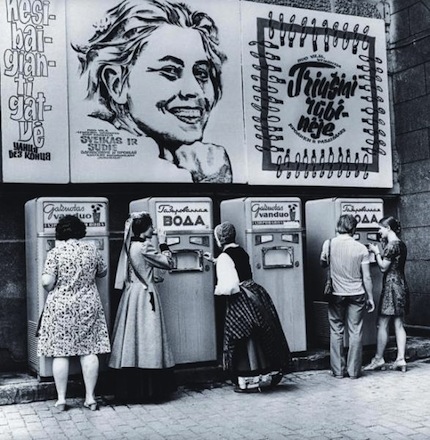
Song Festivals. Rabbits in a Dressing Room. Vilnius, 1970
How did you decide to participate in Darius Mikšys's project “Behind The White Curtain”, as seen in last year's Venice Biennial?
His assistant called me. I will tell you very openly. I am skeptical about the Venice Biennial because it seems that Lithuania knows only the Venice Biennial in which a lot of money is invested. Some years ago, the Latvian pavilion showed the Latvian photographer Inta Ruka.
But the Lithuanian pavillion has always been special. In 2011 we got a special mention, in 2007 – an Honorable Mention for the “Nomeda ir Gediminas Urbonai” project, and in 2005 – a special mention for the Jonas Mekas retrospective.
Yes; because we are preparing projects specially for it, we sort of try to adapt our cultural events towards it. But there is also the MoMa in New York, and we do not do any special actions for it. I do not see the meaning of it. I do not call it art. I call it “KVN” (in Russian: the club of merriment and creativity). Is it spiritual art, in which we can find the answers to our main existential questions, like life, death and love? Or, maybe it can be called sport? And, these projects... How can you call all artworks “projects”? Look – we are now going not to the concert, but to “the project”. Music – a “project”, theater – a “project”. Once, we were in the British Embassy jury with Lukys, and he says – this project is very good. I agreed with him, but I wondered about what kind of exhibition it will be. And then Lukys says - yes, but it is more difficult, more important, to write a proposal for a project. So there is the question, “is art necessary for human beings in this chaotic world?” I find answers in music, in cinematography, in literature; in photography – not so often. A big part of contemporary art, what I have seen of it, is cosmopolitan art. It has nothing specific, nothing national.
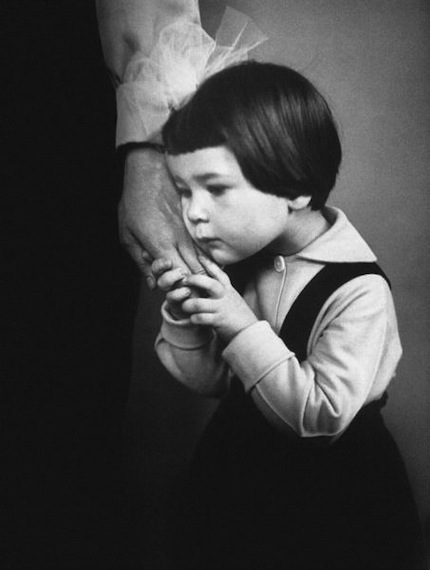
Mother's hand. Vilnius, 1966
Deimantas Narkevičius, who participated in a show in Paris with you recently – he shows rather national themes; they are not about Lithuania per say, but very much tied to the local context and living, but hidden, histories. He often uses the word melancholia, and tries to avoid nostalgia, when speaking about his work.
Everybody is afraid of the word nostalgia because they fear to appear to be longing for the soviet times. Nostalgia and sentimentality, for me, are sacred words. I feel nostalgia for my youth, for my family, my small children, this time-line; but not for whatever party was in rule at the time. People loved, were born and died, both under the fascists and under the communists. Life did not stop during these regimes. Life is the thing for what we feel nostalgia. I am surprised how my works, the ones that are not contemporary, are more interesting than the contemporary works. And then, how can we define the contemporaneity, the now-ness? If I say the word “now”, after two seconds this moment drifts into the past. When we are going to finish the interview, today is going to be yesterday. Art has to be needed by people and, also, by artists, which can not live and express him/herself otherwise. But when I see that people are competing against one another, then what we have is called the Olympics.
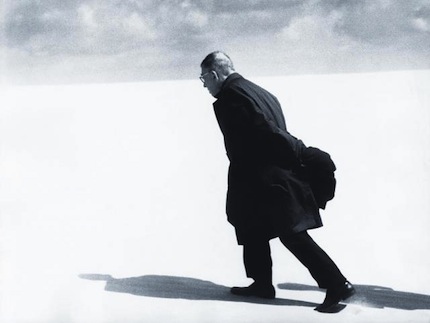
Jean-Paul Sartre in Lithuania. Nida, 1965
How do you see art fairs in this context ? For example, the Frieze Art Fair?
Frieze is a very big art fair. It made a big impression on me. It is like a party of the society's elite. Not everything is being sold, but the most important thing is the meetings which happen during the fair. People are introduced to each other. Actually, I started my sales through Whitespace Gallery, which presented me in London in the 2011 Frieze Art Fair, during which I had the opportunity to meet collectors. British Photography magazine also published an article about me. In my mind, without participating in the fairs, you would not be so interesting to collectors, even if you had an exhibition at Tate. Of course, a show at Tate would definitely mean recognition and prestige. But collecting also has its own nuances. For example, the numbering of editions, in order to indicate their rarity. I want to propose that the quantity of artwork depends solely on its medium. Therefore, an oil painting is unique, but a photo negative also has limits, because you cannot print millions of photographs. Edward Weston, when he printed his last, the thousandth, photograph of his negative, he sold it for 100 thousand US dollars. I find numbering problematic, because how can you know the limits, which work will be sold well?
Maybe a personal art agent could advice you on these questions.
Definitely. For example, in Brazil, there is the Moreira Salles Institute (IMS), founded in 1990, which promotes, develops and disseminates Brazilian photography. The founder of this center was Walter Moreira Salles, a Brazilian banker, politician and philanthropist. Now his children donate money to the Institute, which is situated in the center of Rio de Janeiro. They are buying up all of the collections connected to Brazilian culture.
I, myself, have a public organization – “Photography Archive”, which I can sustain only through the selling of my photographs. Usually, countries buy whole collections and work with them; for example, they use it as a representation of their country. Book publishing and so on. Here, in Lithuania, we only do that with basketball.
Did you take photographs while in Brazil?
I documented a little bit. I was not making pictures, as that is a very difficult venture. At the moment, publishers are constantly reminding me to write my memoirs. But I say that it is too early. On other hand, they are right – now is the time. I am afraid to start writing – becausee I want to write the truth. And it is very hard to write the truth. You have to find the right time to write memoirs – not too soon, but not too late, either.
Antanas Sutkus: an Unrestrained Gaze
Museu Oscar Niemeyer
Through May 20, 2012
www.museuoscarniemeyer.org.br